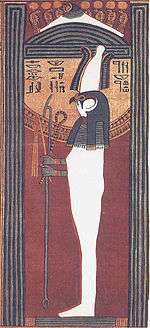Seker

| |||
| Seker in hieroglyphs |
|---|
Seker (/ˈsɛkər/; also spelled Sokar) is a falcon god of the Memphite necropolis.
Name
Although the meaning of his name remains uncertain, the Egyptians in the Pyramid Texts linked his name to the anguished cry of Osiris to Isis 'Sy-k-ri' ('hurry to me'),[1] or possibly skr, meaning "cleaning the mouth".[2] In the underworld, Seker is strongly linked with two other gods, Ptah the Creator god and chief god of Memphis, and Osiris the god of the dead. In later periods this connection was expressed as the triple god Ptah-Seker-Osiris.
Appearance
Seker was usually depicted as a mummified hawk and sometimes as a mound from which the head of a hawk appears. Here he is called 'he who is on his sand'. Sometimes he is shown on his hennu barque which was an elaborate sledge for negotiating the sandy necropolis. One of his titles was 'He of Restau' which means the place of 'openings' or tomb entrances.
In the New Kingdom Book of the Underworld, the Amduat, he is shown standing on the back of a serpent between two spread wings; as an expression of freedom this suggests a connection with resurrection or perhaps a satisfactory transit of the underworld.[1] Despite this the region of the underworld associated with Seker was seen as difficult, sandy terrain called the Imhet (also called Amhet, Ammahet, or Ammehet; meaning 'filled up').[3][4]
Roles and Cults
Seker, possibly through his association with Ptah, also has a connection with craftsmen. In the Book of the Dead he is said to fashion silver bowls[1] and a silver coffin of Sheshonq II has been discovered at Tanis decorated with the iconography of Seker.[5] Seker's cult centre was in Memphis where festivals in his honour were held on the 26th day of the fourth month of the akhet (spring) season. While these festivals took place, devotees would hoe and till the ground, along with driving cattle, which showed that Seker could have had agricultural aspects about him.[2]
Also during the festivals in akhet, his followers had strings of onions around their necks, showing the Underworld part of him. Onions were used in embalming people - sometimes the skin, sometimes the entire onion. When just the skin was used, it would be placed on the eyes and inside the ears to mask the smell.[6]
Also, the god was depicted as assisting in various tasks such as digging ditches and canals. From the New Kingdom a similar festival was held in Thebes, which rivalled the great Opet Festival[2][5]
Other events during the festival including floating a statue of the god on a Henu barque, which was a boat with a high prow shaped like an oryx.[7]
Popular culture
In the 1956 movie The Ten Commandments, the Pharaoh Rameses II invokes the same deity to bring his deceased firstborn son back to life, while portrayed as wearing dark blue robe with a silver bow.
Suggested further reading
Gods & Myths of Ancient Egypt: An illustrated guide to the mythology, religion, and culture By Lucia Gahlin
References
- 1 2 3 The Routledge Dictionary of Egyptian Gods and Goddesses, George Hart ISBN 0-415-34495-6
- 1 2 3 "Sokar". ancientegyptonline.co.uk. Retrieved 2016-10-24.
- ↑ The Egyptian Amduat, Erik Hornung and Theodore Abt ISBN 3-9522608-4-3
- ↑ Budge, E.A. Wallis. An Egyptian Hieroglyphic Dictionary, vol. I. London, 1920.; pgs. 54-55.
- 1 2 The Complete Gods and Goddesses of Ancient Egypt, Wilkinson ISBN 0-500-05120-8
- ↑ Gahlin, Lucia (2014). Gods & Myths of Ancient Egypt. Southwater. p. 46. ISBN 9781780193328.
- ↑ "sokar". ancientegyptonline.co.uk. Retrieved 2016-10-24.
Further reading
- Graindorge, Catherine (1994). Le Dieu Sokar a Thebes Au Nouvel Empire (in French). Otto Harrassowitz Verlag. ISBN 3447034769.
- Mikhail, Louis B. (1984). "The Festival of Sokar: An Episode of the Osirian Khoiak Festival". Göttinger Miszellen 82.